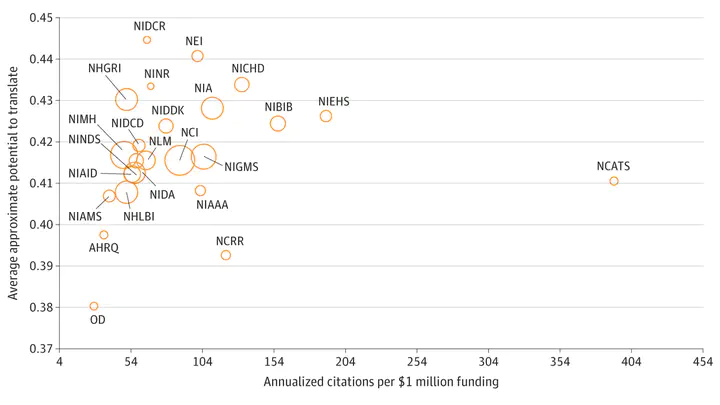Translatability Analysis of National Institutes of Health–Funded Biomedical Research That Applies Artificial Intelligence

Abstract
Despite the rapid growth of interest and diversity in applications of artificial intelligence (AI) to biomedical research, there are limited objective ways to characterize the potential for use of AI in clinical practice.
Objective To examine what types of medical AI have the greatest estimated translational impact (ie, ability to lead to development that has measurable value for human health) potential.
Design, Setting, and Participants In this cohort study, research grants related to AI awarded between January 1, 1985, and December 31, 2020, were identified from a National Institutes of Health (NIH) award database. The text content for each award was entered into a Natural Language Processing (NLP) clustering algorithm. An NIH database was also used to extract citation data, including the number of citations and approximate potential to translate (APT) score for published articles associated with the granted awards to create proxies for translatability.
Exposures Unsupervised assignment of AI-related research awards to application topics using NLP.
Main Outcomes and Measures Annualized citations per $1 million funding (ACOF) and average APT score for award-associated articles, grouped by application topic. The APT score is a machine-learning based metric created by the NIH Office of Portfolio Analysis that quantifies the likelihood of future citation by a clinical article.
Results A total of 16 629 NIH awards related to AI were included in the analysis, and 75 applications of AI were identified. Total annual funding for AI grew from $17.4 million in 1985 to $1.43 billion in 2020. By average APT, interpersonal communication technologies (0.488; 95% CI, 0.472-0.504) and population genetics (0.463; 95% CI, 0.453-0.472) had the highest translatability; environmental health (ACOF, 1038) and applications focused on the electronic health record (ACOF, 489) also had high translatability. The category of applications related to biochemical analysis was found to have low translatability by both metrics (average APT, 0.393; 95% CI, 0.388-0.398; ACOF, 246).
Conclusions and Relevance Based on this study’s findings, data on grants from the NIH can apparently be used to identify and characterize medical applications of AI to understand changes in academic productivity, funding support, and potential for translational impact. This method may be extended to characterize other research domains.